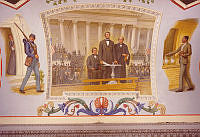Rubenstein Center Scholarship
Enslaved and Entrenched
The Complex Life of Elias Polk
This article is part of the Slavery in the President’s Neighborhood initiative. Explore the Timeline
Elias Polk was born into slavery in 1806 on a farm owned by Samuel Polk, father of the future president of the United States, in Mecklenburg County, North Carolina. Later that year, Elias moved with the Polk family west to Tennessee, where they settled on land near Spring Hill (about 40 miles south of Nashville).1 In 1824, newlyweds James and Sarah Polk were settling into their new home in Columbia, Tennessee. Elias was sent to live with them as a wedding gift from James’s father, Samuel.2 Upon his arrival in Columbia, Elias began working as a valet for James, who had recently been elected to the United States House of Representatives. As an enslaved person, Elias acted as James Polk’s manservant, sometimes driving the carriage carrying Congressman Polk to and from Washington, D.C. While his enslaved status prevented him from directly participating in these conversations, Elias witnessed the turbulence of nineteenth-century politics up close. Click here to learn more about the enslaved households of President James K. Polk.
After a surprise nomination and a rather contentious election, James K. Polk was elected President of the United States in 1844. The Polks, along with several enslaved individuals, including Elias, relocated from their Columbia home to the Executive Mansion in Washington, D.C. Published in 1887, an account in the The Historical Record claimed that after assuming office in 1845, President Polk traveled with Elias to Wilkes-Barre, Pennsylvania on business, where they spent the night. The next morning, while Elias was readying the horses, a group of white men approached him. They told Elias that he was in a free state and if he chose to leave, President Polk could do nothing about it. Elias stunned the group when he replied by telling them, “Do you think I would go back on the President that way? No, sir. You don’t know me. I’d sooner die than run off.”3 James Polk happened to be nearby and overheard this conversation. President Polk was deeply moved and it is reportedly said that the next day he surprised Elias by offering him his freedom. However, Elias declined.
Even though this story is mentioned frequently in the historiography of Elias Polk, its only documented appearance comes from The Historical Record published in 1887. When comparing this episode with the diary and schedule of James K. Polk, this particular story stands out because it is somewhat fictitious. President Polk never made a trip to Pennsylvania in the early part of his administration. Furthermore, when he did visit the Keystone State, he neither visited Wilkes-Barre nor mentioned Elias as part of the entourage. It can be concluded that this story emerged in the latter half of the nineteenth century as a way to cast Elias as a “faithful slave.” Faithful slave narratives were quite common during this time and it appears that some wished to place Elias Polk into this category as some form of political propaganda to further their beliefs of what freed African Americans should be while distorting the legacy of slavery in the United States.

This is an image of Elias Polk from the Daily American newspaper, published in Nashville, Tennessee on December 31, 1886.
Courtesy of the President James K. Polk Home & Museum, Columbia, TennesseeIt is important to remember that in 1845, Elias remained in slavery and as an enslaved man he remained a financial asset to James Polk and his family. From time to time Elias was sent to work for Mr. James H. Thomas, a former law partner to the president, where he remained from late 1845 through 1846. In 1847, Elias returned to the White House and later traveled with the president and first lady to the University of North Carolina, where alumnus James Polk delivered the commencement address. The Polks had been invited to tour the grounds of the university and Elias joined the company that included President and Mrs. Polk, Secretary of the Navy John Mason and his wife Mary Ann, Sarah Polk’s niece, Johanna Rucker, the president’s nephew and secretary, Knox Walker, and officer Matthew Fontaine Maury of the navy.4
When President Polk left office in early March 1849, he and his wife moved into a large Greek-Revival mansion in Nashville, Tennessee that they had purchased in 1847 from the estate of former United States Attorney General, Felix Grundy. Returning with the Polks to Nashville, Elias and three other enslaved people occupied the servants’ quarters that were connected to the mansion through the kitchen. Shortly after returning home, on June 15, 1849 James Polk passed away, another victim of the cholera epidemic that was sweeping through the country.5 Elias remained at Polk Place and through the years would see the nation transform as the result of the impending American Civil War.
On June 8, 1861, Tennessee voted to follow other southern states and secede from the Union. In February 1862, Nashville fell to Union General, Don C. Buell. Buell had relieved General William T. Sherman as commander of the Army of the Ohio in November 1861 and in 1862 he became the Major General of volunteers. Buell was given orders to march on and occupy Nashville but wait until after General Ulysses S. Grant had successfully taken Forts Henry and Donelson.6 After the fall of Nashville, General Buell sent a note requesting permission to visit former first lady Sarah at her home. He was given permission to call on Mrs. Polk, and at around 11 o’clock the next morning, General Buell and his staff of some twenty men, stopped at Polk Place and paid their respects to the widow of the former president. As the group was leaving they noticed Elias standing near the steps, below the portico, and one of the generals asked, “Well, my colored friend, what do you think of this situation [referring to the war]?” Elias quickly responded by saying, “I’m for the rights of the South in the territories!” This unexpected answer caused an uproar of laughter among the men.7 Elias’s reply played directly into the hands of the myth of the “Lost Cause.” The Memorials of Sarah Childress Polk, where this meeting is first recorded, was published in 1892 during a time when southern literature was attempting to rewrite the history of the Civil War to downplay the contribution of slavery to the attempted separation of the Union. However, this story demonstrates Elias’s Confederate sympathies and furthermore, where his loyalties would lie in the years ahead. Click here to learn more about the enslaved households of President Ulysses Grant.

This is the Polk family home in Columbia, Tennessee. Built in 1816 by Samuel Polk, James lived here after graduating from the University of North Carolina in 1818 until his marriage to Sarah Childress in 1824.
Courtesy of the President James K. Polk Home & Museum, Columbia, TennesseeAfter the fall of the Confederacy and his emancipation from slavery, Elias Polk would see his life drastically change during the era of Reconstruction (1865-1877). Following the Civil War, Reconstruction began as a way to reincorporate the southern states that had seceded from the Union. This period also witnessed the occupation of the South by federal troops, the founding of the Ku Klux Klan, the establishment of Republican-run state governments in historically-Democratic areas, and the ratification of the thirteenth, fourteenth, and fifteenth Amendments to the United States Constitution. During this time Elias began to speak out and established himself as a political leader in Tennessee. Elias aligned himself with the Democratic Party and formed a close connection with the white elite throughout the South. Elias took part in the creation of the “Independent Colored Conservative National Club,” an organization of African-American men who opposed Radical Republicanism. On June 15, 1867, eighteen years to the day since his former owner passed away, Elias was elected president of the club. This would just be the first of his many political ventures.8 This was also an odd alignment for a freedman to make, as Elias had been defined by his enslaved status for most of his life. In the era of Reconstruction, a vast amount of support for the Republican Party came from the African-American community.
At one speaking engagement, reported in the Nashville Union and American on June 20, 1867, Elias delivered an empowered address before a large crowd in Davidson County, Tennessee. He claimed that his:
…heart beat with alarm when he contemplated the dangers of the country. What were these dangers? They were enslaving white people by driving them from the ballot-box, and making hostility and enmity between the blacks and whites… They disfranchised 150,000 white men of the state before they gave us, the colored people, the ballot. What was that for? It was to keep power. What did they enfranchise us for? For the same purpose; but they took pains to say that we should not hold office or sit on juries. They made us tools—tools to be used by them. This is wrong—this is unjust. I am for peace and harmony, and in my judgment, there will always be confusion and strife while a part of the people are disfranchised. I am for universal suffrage. These people that are disfranchised are more slaves than I was when I belonged to my old master. We must make all free, for we cannot live in peace any other way.

This portrait of James K. Polk was painted by George P.A. Healy in 1858, nine years after Polk's death.
White House Collection/White House Historical AssociationElias argued that the only reason for African-American enfranchisement was so that the Republicans could create a massive voting bloc that would keep them in power, and therefore he demanded that all men, including ex-Confederates, should have the right to vote. Elias was pointing out what he believed to be the hypocrisy of enfranchising some while disfranchising others. Whether he knew it or not, Elias was slowly becoming more and more of a political voice for the old guard of southern Democrats that would acknowledge his opinions to further their own idealistic version of what African-American men should be after the war. In the same address, Elias then turned his attention to William Brownlow, the Republican Governor of Tennessee. Elias stated that,
I have known Gov. Brownlow for about thirty years. I have heard him myself on three occasions assert that the negro was created by god to be a slave—that slavery was a divine institution—that the negro was no more than a horse or a mule. Do you believe he is our friend? He never pretended to be our friend until now, when he wants our votes…. What makes matters worse with the Governor is, that he professes to be a minister of the Gospel.
Elias became so popular within the Democratic Party that in 1867 it was announced that he was being considered as a conservative candidate for the legislature in Tennessee.9 As a result, he was heavily criticized for his political alignment. One New York Evening Post columnist went out of their way to make the comment, “the Post wants to know what President Polk would have thought of a negro stumping for the Democracy, and says a dozen years ago the Union Democrat would have spelled negro with a double g.”10 Other times, Elias would be portrayed, quite accurately, as a political tool used by southern conservatives to further their influence and voice within the wider African-American community.
On October 11, 1871 it was announced that Elias had been appointed as a porter to the Tennessee State Senate, a position similar to that of a custodian.11 In February 1876, George Adams, Clerk of the United States House of Representatives, appointed Elias Polk to the position of “laborer” at the United States Capitol, as either a reward for his dedication to the party or possibly to show African Americans an example of a “good” Democrat of color.12 Elias relocated to Washington, D.C. and began his work as a laborer at the Capitol where he was paid around sixty dollars a month.13 He held this position until 1881 when the Republican Party regained a majority in the House of Representatives. It must have been of great importance to the Democrats to keep Elias in his position at the Capitol because it was necessary in a Washington Post article from 1882 for the new Clerk of the U.S. House of Representatives, Edward McPherson, to explain why Elias Polk lost his position at the Capitol. McPherson clarified that, “Pressure from the [Republican] party demanded his position and its meagre emoluments, and so the head of Elias fell and was added to the already ghastly heap of Democratic cadavers.”14

This portrait of Sarah Childress Polk was painted by George Dury in 1883, 34 years after the Polks left the White House. It was given to the Executive Mansion by the Ladies of Tennessee, and modeled after George P.A. Healy's 1846 portrait of Mrs. Polk.
White House Collection/White House Historical AssociationIn his advanced age, Elias engaged in Democratic political events less frequently, yet he still remained a fervent supporter of the Democratic Party. In 1886, he returned to Washington, D.C. to meet President Grover Cleveland, the first Democrat president since James Buchanan. On the day Elias Polk visited the White House, so did one hundred others, eager to greet the president.15 After waiting in line for well over an hour, Elias was the last person to shake hands with President Cleveland, whom he referred to as “a Democrat of the old school.”16 While on this trip to Washington, D.C., Elias fell ill and died on December 30, 1886.17 Today his remains are interred at Nashville City Cemetery in Nashville, Tennessee.
During his life, Elias Polk went from being enslaved in the White House to one of the most controversial African-American political activists of his day. He always maintained the Democratic principles that he likely inherited from his former owner. Though much of the historical information on Elias Polk is anecdotal, the stories are consistent in their portrayal of Elias’s attitudes toward slavery and freedom. As a result, Elias Polk’s experiences complicate the story of the South during Reconstruction. His political affiliation and dedication to his party show an odd trend in the record. He is commonly depicted as being “faithful” to the white southern aristocracy that would have re-enslaved him, had they been given the chance. Through his political activism, Elias was able to gain a sense of social mobility and autonomy at the cost of giving credence to the returning racial hierarchy that had dominated the South for centuries. His narrative, when taken out of context, represents that of a “faithful slave,” one who remained a “tool” to be used by the old guard of the South for some nefarious political purpose. Yet, his story cannot be overlooked because it provides a deeper understanding of the political tug-of-war and power struggle in the South following the Civil War and how this period in which Elias lived is remembered today.
A native of Maury County, Tennessee, Zacharie W. Kinslow holds a masters degree from Austin Peay State University. For five years he worked at the President James K. Polk Home & Museum in Columbia, Tennessee as a docent and educator. Zacharie’s research interests primarily involve slavery and the America presidency as well as Jacksonian America.

This portrait of Grover Cleveland was completed by Eastman Johnson in 1891. President Cleveland met Elias Polk at a mid-December 1886 reception at the White House.





